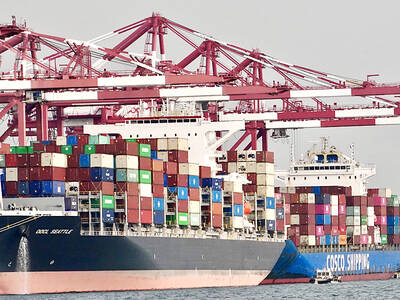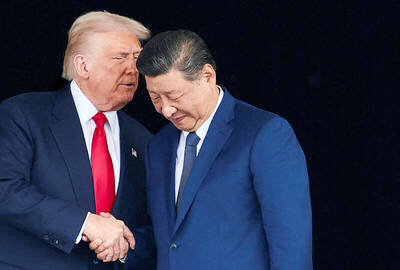US President Barack Obama announced on Saturday the framework for a vast free-trade agreement spanning the Pacific as he sought a new era of US leadership in a fast-growing region.
“Together we can boost exports and create more goods available for our consumers, create new jobs, compete, win in the markets of the future,” Obama said, framing the Asia-Pacific as the key to restoring global economic growth.
Leaders from nearly 20 nations, including China and Japan, gathered for weekend meetings in Hawaii, where sunbathers and surfers had to skirt beach barricades and traffic snarls frustrated the famously laid-back locals.
Obama said nine countries had reached a “broad outline” on a free-trade pact called the Trans-Pacific Partnership (TPP) and hoped by next year to be working on the legal text of a full agreement.
Japanese Prime Minister Yoshihiko Noda gave a major boost ahead of the summit as his nation became the 10th member of the TPP, meaning that it will cover more than one-third of the global economy and could develop into the world’s biggest free-trade zone, dwarfing the EU.
“I have been extremely impressed already with the boldness of his vision,” Obama said after meeting Noda ahead of yesterday’s formal opening of the APEC forum.
Obama has set a goal of doubling exports to create badly needed jobs at home, but he also hopes that the TPP will serve as a strategic linchpin as the US winds down wars in Iraq and Afghanistan and refocuses on Asia.
Pressing the US case for the TPP, Obama said that the emerging -agreement would be a 21st-century deal that ensures high environmental and labor standards and addresses new barriers other than tariffs.
“I’m confident we can get this done,” he said.
The TPP was signed in 2005 as an obscure agreement among Brunei, Chile, New Zealand and Singapore. Obama suddenly turned it into the cornerstone of the US’ free-trade drive, with Australia, Japan, Malaysia, Peru, the US and Vietnam now also in the talks.
In a joint statement, leaders of TPP nations said they shared a “strong interest” in expanding their membership.
The major outlier of the TPP is China, the world’s second-largest economy. Obama, shortly before holding talks with Chinese President Hu Jintao (胡錦濤), warned that Beijing must “play by the rules” in international trade and intellectual property protection.
The US has not explicitly ruled out China’s entrance into the TPP, but US Secretary of State Hillary Rodham Clinton has linked the trade agreement to fundamental values, including openness and labor standards.
“It’s very important for China to join eventually, and China has left that possibility open,” said Peter Petri, an expert from the East-West Center thinktank.
“There are now differences between the US and China on some provisions, for example, rules about trade by state-owned enterprises. But it’s best to think of this not as breaking up the region, but as a move in a ‘bargaining game’ about what rules will govern cooperation,” Petri said.
Despite the US’ optimism about the TPP, Obama said that there would be “difficulties” and “sensitivities” among member countries. Most experts believe it will take years before a concrete agreement can come to fruition.
The details of the trade agreement remain vague and opposition has already built in several countries. Some farm groups in Japan and the US have voiced alarm that they would be swamped by global competition.

The Central Weather Administration (CWA) yesterday said it expected to issue a sea warning for Typhoon Fung-Wong tomorrow, which it said would possibly make landfall near central Taiwan. As of 2am yesterday, Fung-Wong was about 1,760km southeast of Oluanpi (鵝鑾鼻), Taiwan’s southernmost point, moving west-northwest at 26kph. It is forecast to reach Luzon in the northern Philippines by tomorrow, the CWA said. After entering the South China Sea, Typhoon Fung-Wong is likely to turn northward toward Taiwan, CWA forecaster Chang Chun-yao (張峻堯) said, adding that it would likely make landfall near central Taiwan. The CWA expects to issue a land

Taiwan’s exports soared to an all-time high of US$61.8 billion last month, surging 49.7 percent from a year earlier, as the global frenzy for artificial intelligence (AI) applications and new consumer electronics powered shipments of high-tech goods, the Ministry of Finance said yesterday. It was the first time exports had exceeded the US$60 billion mark, fueled by the global boom in AI development that has significantly boosted Taiwanese companies across the international supply chain, Department of Statistics Director-General Beatrice Tsai (蔡美娜) told a media briefing. “There is a consensus among major AI players that the upcycle is still in its early stage,”

The Central Weather Administration (CWA) yesterday said it is expected to issue a sea warning for Typhoon Fung-wong this afternoon and a land warning tomorrow. As of 1pm, the storm was about 1,070km southeast of Oluanpi (鵝鑾鼻), Taiwan’s southernmost point, and was moving west-northwest at 28 to 32kph, according to CWA data. The storm had a radius of 250km, with maximum sustained winds of 173kph and gusts reaching 209kph, the CWA added. The storm is forecast to pass near Luzon in the Philippines before entering the South China Sea and potentially turning northward toward Taiwan, the CWA said. CWA forecaster Chang Chun-yao (張峻堯) said

‘SECRETS’: While saying China would not attack during his presidency, Donald Trump declined to say how Washington would respond if Beijing were to take military action US President Donald Trump said that China would not take military action against Taiwan while he is president, as the Chinese leaders “know the consequences.” Trump made the statement during an interview on CBS’ 60 Minutes program that aired on Sunday, a few days after his meeting with Chinese President Xi Jinping (習近平) in South Korea. “He [Xi] has openly said, and his people have openly said at meetings, ‘we would never do anything while President Trump is president,’ because they know the consequences,” Trump said in the interview. However, he repeatedly declined to say exactly how Washington would respond in